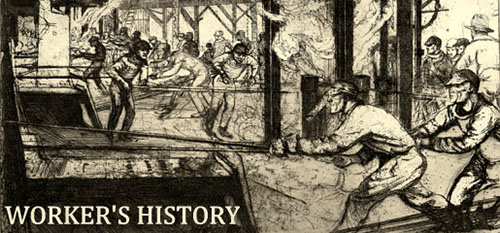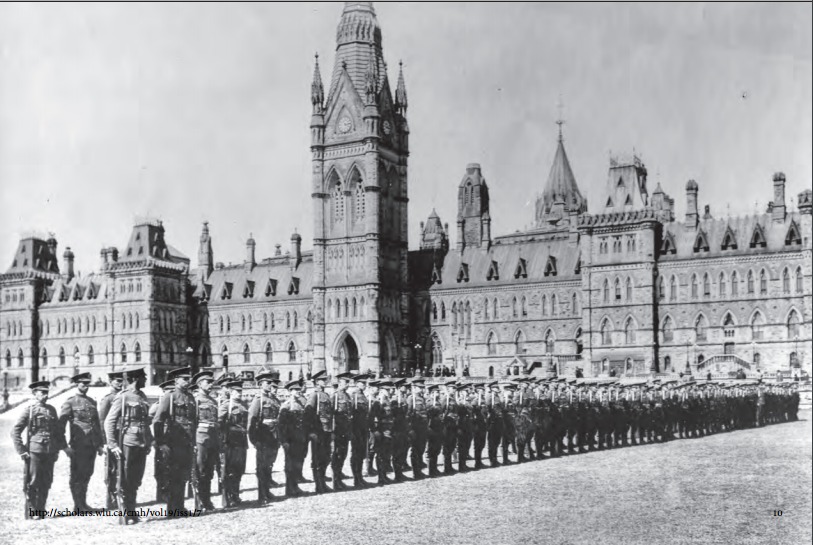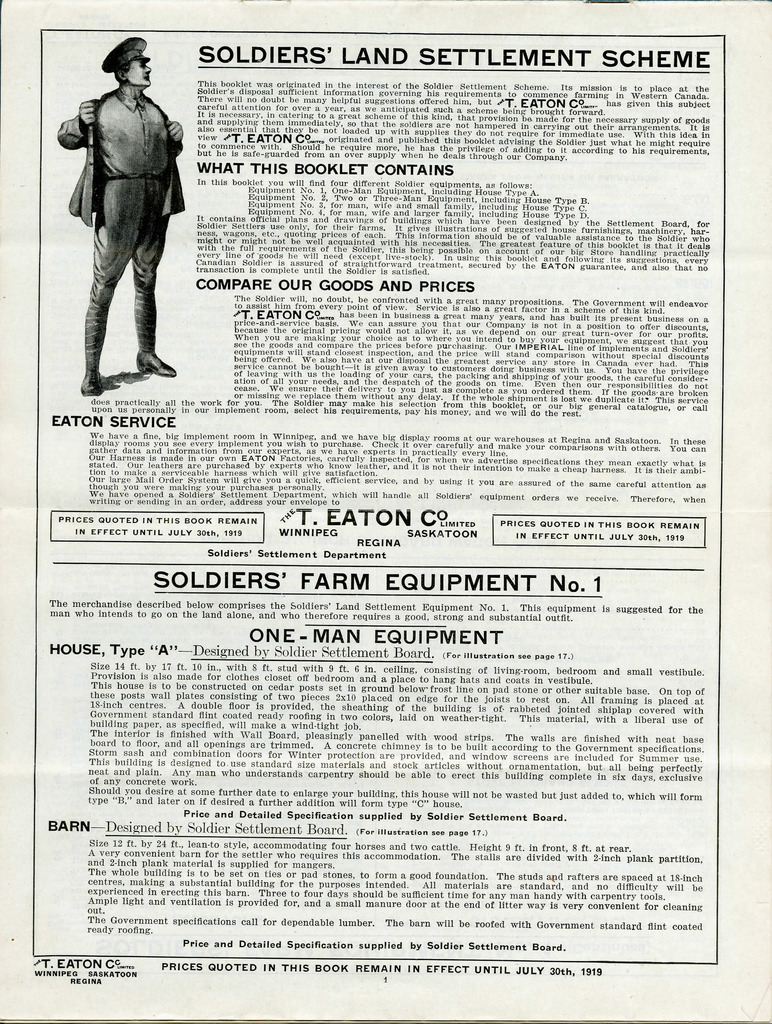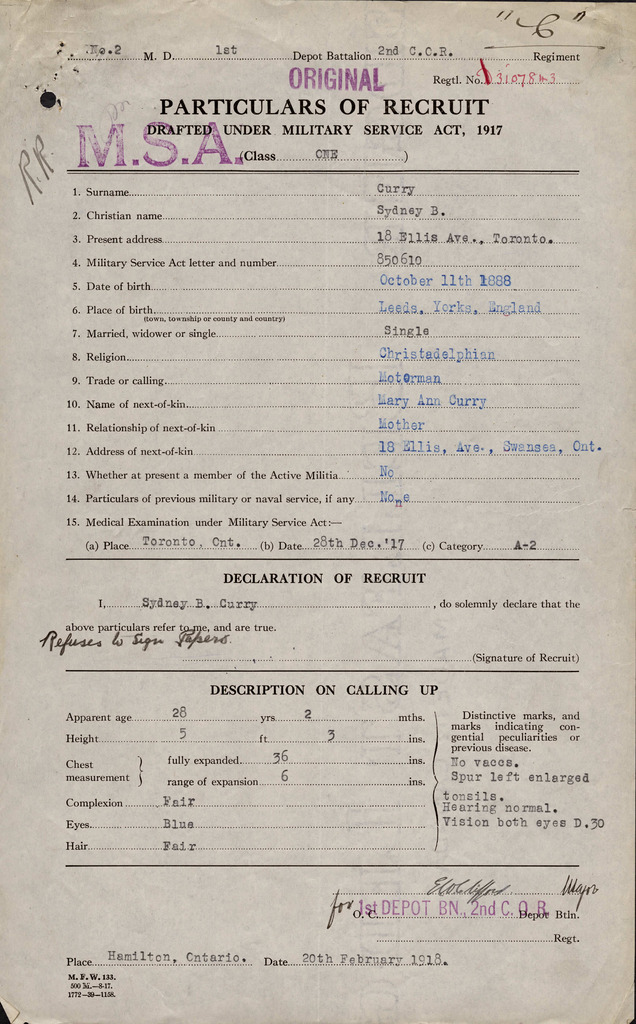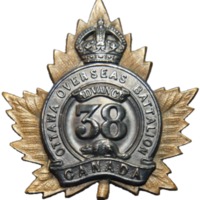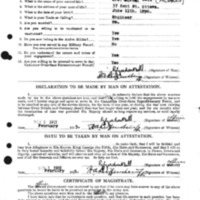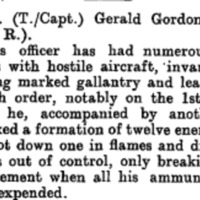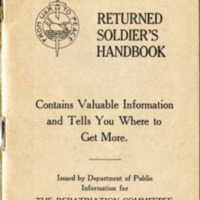Soldiers
Nearly 620,000 Canadians enlisted with the Canadian Expeditionary Force during the First World War. Ottawa was represented by the 38th Battalion, which saw action alongside the CEF in battles such as the Somme, Arras, Vimy Ridge, Ypres, and Passchendaele. Men who attested often listed themselves simply as "laborer" or "farmer," but others could be more specific. Stove moulders, sheet metal workers, bakers, carpenters and railroaders were some among the many soldiers from Ottawa.
Many veterans returned to their old professions after demobilization. One example is Captain Gerald Gordon Bell, an engineer before the war, who attested with the 38th Battalion 1915. He saw action on the Somme before he was seconded to the Royal Flying Corps in 1917, where he became an ace pilot credited with as many as sixteen aerial victories. Awarded the Distinguised Flying Cross, the Legion d'Honneur, and the Croix de Chevalier, Bell returned home to Ottawa and resumed his job as an engineer.
Upon discharge, Canadian soldiers had access to the Returned Soldiers Handbook, which provided information on what to do after discharge. This included resources on vocational training and employment, noting that the Department of Labour established government employment offices in Ottawa on Queen Street, as well as in other cities over 10,000 population. It also directed soldiers towards the Soldier Settlement board were they interested in land grants.
The Soldiers' Land Settlement Act was passed in 1917. As many had joined the military as an opportunity to escape poverty and unemployment, this act offered loans to men determined to be fit to manage a farm. The soldiers’ land settlement board board noted that “There had been a strong drift cityward in the years preceding the armistice. Thousands of our soldier lads returned from overseas with plans as to the future unformed. Many of them possessed small capital, possibly little more than their gratuity and post-discharge pay … Without question, few of the soldier settlers would have been in a position to take up land of their own had it not been for Government aid.” A soldier’s fitness to farm was a priority, and unfitness could disqualify a soldier’s candidacy. The board’s 1921 report painted this picture: “There is no other business where the difficulties and discouragements are so numerous : limited capital, isolation, arduous labour, crop failure, pests, hail, frost and drought are incidents of the farmer's life, but formidable obstacles to the beginner.” The Soldier Settlement Board granted veterans up to 320 acres of land, as well as loans for the procurement equipment and livestock. 4,854,799 acres of land across Canada were granted to soldier settlers by 1921, with $10,562,239 spent on livestock, not including the thousands purchased without the aid of board loans. While many of the soldiers were settled in the prairie provinces, others were settled across Ontario. While 4,067 applicants were considered qualified, another 1,680 were disqualified, and only 1,442 were granted loans by March 1921.
Many ex-soldiers returned from Europe disabled and unfit to farm. Finding work could be very difficult for disabled veterans, though this issue was not ignored. A 1918 circular by the "Invalidated Soldiers Commission" was published in Ottawa with the aim of providing guidance on how to reintegrate these men into the work force. Courses which offered re-education geared towards industry were established in Toronto and Montreal, but many were inclined to work in commerce, Civil Service and other sedentary occupations. With Ottawa as a centre for the Civil Service, there were opportunities available to such veterans.
Sources:
Canadian War Museum https://www.warmuseum.ca/firstworldwar/objects-and-photos/photographs/post-war-photographs/demobilization/?back=482
Reynolds, Ken, "38th Battalion." https://cefresearch.ca/matrix/Army%20Corps/Divisions/4th%20Division/12th%20Infantry%20Brigade/38th%20Battalion.htm
Reynolds, Ken (2010) "A “Soldier of the Line” Sergeant John Anderson Church, 38th Battalion, CEF," Canadian Military History: Vol. 19: Iss. 1, Article 7.
Library and Archives Personnel Records Database, 38th Battalion
"Bell, Gerald G." - RG 150, Accession 1992-93/166, Box 613 - 9 35951
1921 Canada Census Reference Number: RG 31; Folder Number: 76; Census Place: St.George´s Ward, Ottawa, Ontario; Page Number: 31
Supplement to the London Gazette, 2 November 1918 (30989/12962)
https://www.thegazette.co.uk/London/issue/30989/supplement/12962
